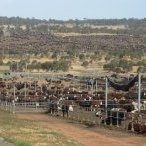
15 September 2009 | Interviews | Food Sovereignty
Mobile monoculture
Sergio Schleschinger, from Food&Water Watch, analyzes “cattle monoculture”
length: 2:08 minutes
Download: MP3 (1.6 Mb)
Cattle production has been growing in Brazil at the expense of the deforestation of the Amazon, displacing other types of production, without generating jobs and making use of the technological package of transnational corporations that makes it another monoculture.
There are 200 million live stock in Brazil, in approximately 200 million hectares of land.
Brazil is the world’s largest meat producer.
Although only India has more live stock than Brazil, due to religious and cultural reasons those animals do not have a commercial value.
Sergio Schleschinger of Food & Water Watch, analyzed the cattle growth in Brazil, especially focusing on the areas of the Amazon that were deforested.
This model is based on a technological package that implies soy production for animal feed and the use of hormones- developed by transnational corporation Monsanto – to increase milk production, for example.
According to an analyst, nearly 64 % of deforestation in Brazil is the result of paving the way for cattle growing.
During the Regional Forum Against Agribusiness organized by Friends of the Earth International, La Via Campesina and the World March of Women in Asuncion, Paraguay, Schleschinger said that a growing percentage of greenhouse gas emissions produced by Brazil are caused by cattle growing.
This adds up to the damage of the Amazon, leading to a dramatic environmental, social and economic situation for the Latin America.
Another example mentioned by the Brazilian analyst was the few employments generated by extensive cattle growing in Brazil.
He said that according to a 2004 study, 100 hectares of tomato plantations generated 255 jobs.
The same area planted with grapes generated 103 jobs, while export monocultures like sugar cane plantations employ only ten people per 100 hectares and cattle growing requires a minimum of 400 hectares to generate barely one job.
Cattle growing in Brazil is dominated by Brazilian transnational corporations that are expanding to Argentina and Uruguay, which are almost monopolies in those countries and make use of Brazilian public funds through the Economic and Social Development Bank (BNDES).
Photo: feedlot,
Source: lanacion.com.ar







